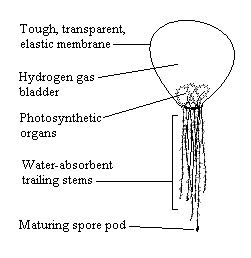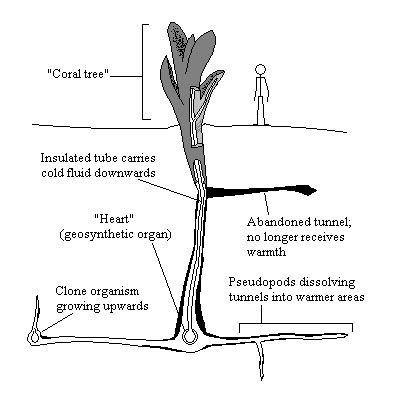Here are three flora elements found in various environments in Enathal, the world I am building.

Two are plants; the last one isn't really a plant, but is a sedentary autotroph--close enough! I had fun trying to tailor them to their environments. The names are placeholders until I figure out more language stuff. Feel free to comment, criticize and/or ask questions.
1. "Balloon Algae"

I figure this would have evolved from some sort of algae, anyways. Here's how it works. It grows in warm, tropical-ish parts of the ocean, photosynthesizing in the usual manner and absorbing minerals from the water. After gaining a certain amount of mass, it starts a new kind of photosynthesis in which it splits water into hydrogen gas and oxygen gas. It lets go of the oxygen into the sea, but saves up the hydrogen in a growing bladder of a tough, elastic membrane. Soon, enough hydrogen gas accumulates that it bobs to the surface of the water. Now it's in direct sunlight, and can efficiently keep splitting water, making the bladder grow bigger and bigger, until it becomes a balloon that starts lifting itself out of the water. It has trailing stems still dipping in the water, so it keeps sucking up water, splitting it, and inflating the balloon, lifting it higher.
As soon as the trailing stems clear the water, they begin to dry out (they're spongy, so they carry a lot of water) causing the organism's net mass to decrease quickly. Up it goes!
Sailing with the wind, it quickly runs out of water. But there's plenty of oxygen gas around, and it has a store of hydrogen inside itself. So it starts metabolically combusting hydrogen and oxygen, the exact reverse of what it was doing before. This process produces both water and energy to sustain it while it flies. And as it goes, it produces spores and releases them into the wind, scattering them far and wide.
As it uses up its store of hydrogen, it is of course losing its lifting gas. It loses altitude, coming down and down until its trailing stems are caught by a wave, which saturates them with water and pulls the thing securely down, to start the cycle again. If it has the misfortune of coming down on land, it dries out and dies.
It is used by many peoples to produce cheap fuel and lifting gas for airships. I've toyed with the idea of rigging up a large number of them in a net with a tank of water and a cabin below as a makeshift airship itself, but don't know if that's feasible or worth it.
Inspiration from the floating Jellyfish in Kenneth Oppel's second Airborn novel and the floating islands of plants in Bespin's atmosphere, encountered in some of the Young Jedi Knights books.
2. "Water Catcher"

Environment:
The human-inhabited part of Enathal is a giant, flat disk, with gravity pulling inward on both sides. One side, called Orathal, is earth-like and primarily ocean. The other side, called Ephathal, has little water and plantlife. These plants grow in bare-bedrock-covered regions of Ephathal that rarely receive rain.
The difficulty for plants in this area is that there is little soil to hold water. When rain comes (which is regular but not frequent) it collects in shallow depressions in the bedrock and quickly evaporates, leaving nothing for months. The Water Catchers are the basis for the sparse ecosystem that does exist in these areas, because they hold water down against the heat and dry air.
They grow in depressions where water collects, and when they get a brief feast of water, they suck up as much of it as they can and churn out oil. This oil doesn't evaporate easily and is liquid at local temperature, and it drips down and soaks into whatever sparse sand is around the roots of the plant. Further rains, more oil. After some time (I don't have a good estimate for how long, right now), enough oil will accumulate that incoming water (which is heavier than oil) will sink underneath it and displace it upwards. The oil will now begin to act as a shield against evaporation. This begins a snowball effect (albeit a slow one) where the plant can hold on to more water for longer with each rain. Fast-forward more years, and the mature plant sits in a pool of water with a thick layer of oil on top, and it can now spare the water and energy to attempt to reproduce (Although, more likely than not, other Water Catchers will have already germinated in the pool as it has spread). To make its seeds attractive to the small animals that will carry them, the plant enfolds them in juicy flesh--a small, reluctant offering of water from its precious hoard. And why would the small animals not partake of the pool below, the water not offered? Naturally, the Water Catcher infuses both the oil and the water below with savage poisons.
Travelers who find themselves in this forsaken part of Enathal can subsist largely on the oil and water of these pools, if they have means to remove the poisons. Some creatures may have developed the ability to metabolize these poisons, but predators keep their population in check and thus preserve the pools from overexploitation.
Inspiration from chemistry class.
3. "Coral Trees"

Environment: plains of cold volcanic ash in Ephathal, cinder cones of dormant volcanoes; specifically in areas too cold for normal plant growth, but where geothermal energy is available.
Water is usually the limiting resource for growth in Ephathal. In cold places, water accumulates as snow--but is useless as long as it remains frozen. These sedentary creatures kill two birds with one stone by using geothermal heat to melt the snow and obtain water, and harvest energy from the temperature gradient as they do it.
The main body is vertical, stretching from the "coral tree" structure at the surface down to the "heart", which is usually as far down as possible. In the center of the main body is a large tube, insulated with fat. On the outside of the insulation, small tubes carry warm circulatory fluid up from the heart. At the coral tree, the heat radiates away, melting any recently fallen snow (pores in the coral tree collect some of the water), and the cold fluid returns down the to the heart, now inside the insulated tube (the fatty insulation prevents it from warming up much on the way down).
At the heart, the cold fluid emerges from its insulated tube, now deep underground. The geothermal heat all around means that the heart holds a very sharp heat gradient. This organ uses thermosynthesis ("geosynthesis", after looking it up, apparently means something entirely different

) to capture usable energy from the gradient.
From the main body, pseudopods extend outwards, secreting acids to dissolve the minerals in the compressed ash and make tunnels. These have two functions. Firstly, they act as secondary circulation and absorb more warmth to be carried back to the heart. Secondly, when a sufficiently warm spot is found at a sufficient distance from the heart, the organism will reproduce by cloning itself at the new location; starting with a new heart and then a new main body digging its way upwards towards the surface. As the pseudopods dig, the dissolved minerals are carried away and deposited as part of the coral tree. The coral tree, with its many lobes, serves to increase the surface area from which the organism can radiate heat while not exposing itself to predators and the elements.
Inspiration from all those little thingies that live near hydrothermal vents the the bottom of the ocean.






 ) to capture usable energy from the gradient.
) to capture usable energy from the gradient.


